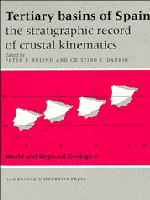Book contents
- Frontmatter
- Contents
- List of contributors
- Preface
- Dedication to Professor Oriol Riba IArderiu
- Memorial, Etienne Moissenet 1941–1994
- PART G GENERAL
- PART E EAST
- PART W WEST
- PART C CENTRE
- PART S SOUTH
- S1 The Betic Neogene basins: introduction
- S2 Neogene palaeogeography of the Betic Cordillera: an attempt at reconstruction
- S3 Depositional model of the Guadalquivir – Gulf of Cadiz Tertiary basin
- S4 Late Neogene depositional sequences in the foreland basin of Guadalquivir (SW Spain)
- S5 Miocene basins of the eastern Prebetic Zone: some tectono sedimentary aspects
- S6 Stratigraphic architecture of the Neogene basins in the central sector of the Betic Cordillera (Spain): tectonic control and base-level changes
- S7 Pliocene–Pleistocene continental infilling of the Granada and Guadix basins (Betic Cordillera, Spain): the influence of allocyclic and autocyclic processes on the resultant stratigraphic organization
- S8 Late Neogene basins evolving in the Eastern Betic transcurrent fault zone: an illustrated review
- S9 Tectonic signals in the Messinian stratigraphy of the Sorbas basin (Almeria, SE Spaín)
- S10 Basinwide interpretation of seismic data in the Alborán Sea
- Index
S9 - Tectonic signals in the Messinian stratigraphy of the Sorbas basin (Almeria, SE Spaín)
Published online by Cambridge University Press: 04 August 2010
- Frontmatter
- Contents
- List of contributors
- Preface
- Dedication to Professor Oriol Riba IArderiu
- Memorial, Etienne Moissenet 1941–1994
- PART G GENERAL
- PART E EAST
- PART W WEST
- PART C CENTRE
- PART S SOUTH
- S1 The Betic Neogene basins: introduction
- S2 Neogene palaeogeography of the Betic Cordillera: an attempt at reconstruction
- S3 Depositional model of the Guadalquivir – Gulf of Cadiz Tertiary basin
- S4 Late Neogene depositional sequences in the foreland basin of Guadalquivir (SW Spain)
- S5 Miocene basins of the eastern Prebetic Zone: some tectono sedimentary aspects
- S6 Stratigraphic architecture of the Neogene basins in the central sector of the Betic Cordillera (Spain): tectonic control and base-level changes
- S7 Pliocene–Pleistocene continental infilling of the Granada and Guadix basins (Betic Cordillera, Spain): the influence of allocyclic and autocyclic processes on the resultant stratigraphic organization
- S8 Late Neogene basins evolving in the Eastern Betic transcurrent fault zone: an illustrated review
- S9 Tectonic signals in the Messinian stratigraphy of the Sorbas basin (Almeria, SE Spaín)
- S10 Basinwide interpretation of seismic data in the Alborán Sea
- Index
Summary
Abstract
The Messinian (Late Miocene) stratigraphic record of the Sorbas basin (SE Spain) comprises two major sedimentary cycles that can be correlated with the TB 3.3 and TB 3.4 cycles of Haq et al. (1987). The lower cycle consists of a temperate-carbonate unit assigned to the Low-Systems Tract and bioherm and fringing reef units representing the Transgressive and High-Stand parts respectively. The upper cycle consists of a selenite–gypsum unit (Low-Stand), a marine, stromatolite-bearing unit corresponding to the Transgressive Systems Tract, and an alluvial, continental unit representing the High-Stand.
Tectonic movements were involved in the formation of the unconformities at the base of both major, third-order cycles as well as at the boundaries and interruptions of some high-order ones. The unconformity at the base of the lower cycle reflects the combined effects of the sea-level fall at the end of the last Tortonian cycle (TB 3.2 of Haq et ai, 1987) and a pulse of tectonic uplifting affecting the southern margin of the basin (Sierra Alhamilla). As a consequence of this, temperate, shallow-water carbonates lie directly on top of deep-water, submarine-fan deposits around the Sierra Alhamilla.
The unconformity separating both major Messinian cycles may be correlated with a global sea-level fall and may perhaps reflect the main evaporite event of the Mediterranean region.
- Type
- Chapter
- Information
- Tertiary Basins of SpainThe Stratigraphic Record of Crustal Kinematics, pp. 387 - 391Publisher: Cambridge University PressPrint publication year: 1996
- 20
- Cited by



